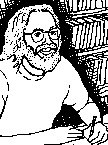
2006 Educator of the Year prompt:
William Butler Yeats said, “Education is not the filling of a pail, but the lighting of a fire.” How is this quote applicable to your students, teaching methods, and the university’s liberal arts mission?
As Yeats well knew, filling a pail is easy; lighting a fire is risky and unpredictable. I take pride in being incendiary. David Horowitz has recently included me in his book The Professors: The 101 Most Dangerous Academics in America. Colleagues assure me that far from being the insult he intended it to be, it represents an acknowledgment of my success as a teacher, scholar, and activist. Being included in a list of such esteemed professors as Noam Chomsky, Howard Zinn, bell hooks, Eric Foner, Manning Marable, and Angela Davis is indeed both humbling and exhilarating.
Horowitz criticizes me for teaching outside of my field.1 Teaching outside of our areas of expertise, however, is precisely what a successful liberal arts education requires. In my case, my area of expertise is a January 1931 Indigenous strike in the canton of Cayambe in the rural highlands of northern Ecuador, South America. Limiting our teaching to our specific research interests would result in very constrictive and dry courses. I would feel perfectly at ease teaching this topic because I know it well. Teaching all of Latin American history involved more risks. In order to light fires, we need to extend our teaching horizons significantly beyond our narrow research interests, and to embrace the unknown.
Although Horowitz does not define what he considers to be my field and what specific courses I teach outside of that field, my Junior Interdisciplinary Seminar (JINS) course on Race, Class and Gender in Latin America is the one that falls the most clearly outside of my area of academic training. Yet, a liberal arts education values and even requires such courses that examine intersections between disciplines and interrogate their central assumptions. A key goal of teaching outside our fields is to transcend dichotomies that pit disciplines against each other and instead move toward an integrated synthesis which reflects the benefits of utilizing the tools of various disciplines to understand a problem.
Horowitz also criticizes me for “participation in protests against free trade talks in Latin America, including his numerous trips to condemn ‘Western intrusion’ in Ecuador, one of Latin America’s most stable democracies.”2 Historian E.H. Carr observes that facts are a duty, not a virtue.3 Facts are a fundamental building block of our discipline, but Horowitz discards them when inconvenient or when they do not fit his ideology. Since Independence from Spain in 1822, Ecuador has only had nine constitutionally elected presidents who have successfully completed their terms in office and passed the banner on to a duly elected successor. In the last 10 years not one chief executive has completed an elected term in office, and there have been at least three extra-constitutional changes of power. Despite Horowitz’s assertion, next to Haiti and Bolivia Ecuador is the least stable democracy in Latin America.
While Horowitz condemns me for bringing my experiences on the streets of Latin America into a Missouri classroom, it is these direct observations which help me light a fire of passion for Latin American history among my students. Without such direct experiences, the educational experience would become much more akin to the filling of a pail.
Horowitz also criticizes me for an alleged “antipathy toward the United States.”4 Although I am clearly and unequivocally opposed to the current Bush Administration’s policies of imperial aggression and violations of constitutional and international law, it is unclear how that translates into an antipathy toward the United States itself. Does standing up against tyranny and judicial abuses not place me in the strongest and proudest tradition of what it means to embrace the values on which the United States was founded? I value an active and engaged citizenship, and through my words and actions attempt to model behaviors to realize Truman State University’s goal of cultivating students who aspire “toward the best for oneself, one's family, one's society, and the world.”5
Horowitz implies, without providing any evidence, that I use my classroom as a space for indoctrination of students. Indoctrination, however, is more akin to the filling of a pail than the lighting of a fire, and runs directly counter to sound educational pedagogy. As I note in my statement of teaching philosophy, “it is more important to teach students how to think than what to think.” I maintain that it is important for professors to engage students “with alternative viewpoints that challenge existing assumptions and encourage critical thinking.”6 But I also provide students with tools and space to draw their own conclusions, even if it leads a student to the conclusion that Horowitz is right and my classrooms are indoctrination sessions.
Attachments:
1. “Professor Marc Becker” in Horowitz, 50-51
2. Marc Becker, “Teaching Philosophy.”
3. Latin America Revolutions (HIST 391): Seminar on Revolutionary Theories (Course Syllabus).
Marc Becker
Associate Professor of History
March 8, 2006
1. David Horowitz, The Professors: The 101 Most Dangerous Academics in America (Washington, DC: Regnery Pub., 2006), xxiii.
3. Edward Hallett Carr, What is History? (New York: Knopf, 1961), 8.
5. Truman State University, “University Mission,” http://www.truman.edu/pages/17.asp.
6. Marc Becker, “Teaching Philosophy.”